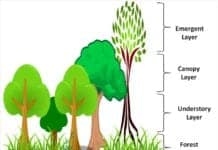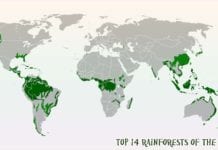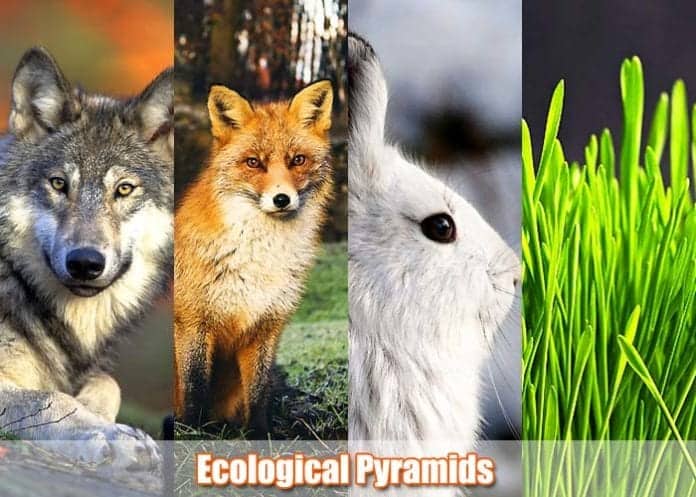
Ecological Pyramids: An ecosystem is defined as a community composed of both living and nonliving entities that altogether live and work together.
Ecosystems have no definite sizes as they can be as small as a tree or as large as the whole land mass. Ecosystems are broken into different ranks called trophic levels.
Every organism then is classified based on different environmental factors like how they live in a certain ecosystem (what they eat and how they obtain energy). Organisms that make their own food using the sunlight are called producers.
Table of Contents
The next level in the hierarchy is the consumers that consume the producers and they are categorized as primary, secondary, or tertiary. Primary consumers are the ones that feed on the producers, secondary consumers are the organisms that consume the primary consumers, and the tertiary consumers are the ones that consume both primary and secondary consumers.
Ecologists have devised certain ways to classify organisms into trophic levels and one of which is the use of ecological pyramids. Let’s take a closer look.
![]()
What is an Ecological Pyramid?

In 1927, the concept of ecological pyramid[1] was first proposed by English Ecologist named Charles Elton (1900-1991) (thus, they are also known as Eltonian pyramids). An ecological pyramid is basically a pyramidal depiction of the number of organisms, biomass, and productivity in each trophic level in an ecosystem.
- Typically, ecological pyramids start with producers located at the bottom and transcend through various trophic levels as you go up the pyramid. The top of the pyramid represents the highest level in the food chain.
![]()
Why are ecological pyramids shaped as pyramids?
When the food passed from primary producers to secondary consumers and then to tertiary consumers (carnivores), it is estimated that about 10% of energy is lost during the process. To graphically explain this concept, ecologists came up with the pyramid diagrams, hence the ‘Ecological Pyramids.’
![]()
Three Major Types of Ecological Pyramid
Three major types of ecological pyramids exist: pyramid of number, biomass, and energy. They are described as follows.
1. Pyramid of Number
- This type of pyramid can have two different forms depending on the number of organisms: upright and inverted.
- In an upright pyramid of number, the number of organisms generally decreases from the bottom to top. This generally occurs in grassland and pond ecosystems where the plants (usually the grasses) occupy the base of the pyramid. The succeeding levels of the pyramid include the consumers.
- An inverted pyramid of number, on the other hand, is just the opposite of the former. It is usually observed in tree ecosystems with the trees as the producers and the insects as consumers.
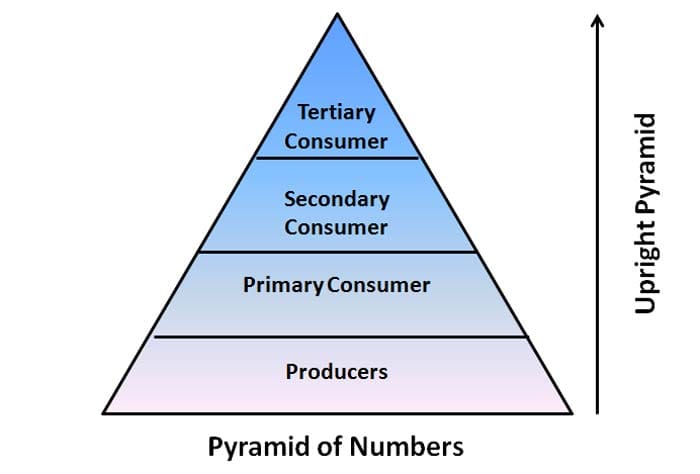 Among the three types of ecological pyramids, the pyramid of number is the least accurate for it does not take account the exact number of population and therefore cannot completely define the trophic structure in that ecosystem.
Among the three types of ecological pyramids, the pyramid of number is the least accurate for it does not take account the exact number of population and therefore cannot completely define the trophic structure in that ecosystem.
![]()
2. Pyramid of Biomass
- For instance, a pyramid of biomass is a depiction of the amount of food available and how much energy is being passed on at each trophic level. Most the biomass that animals consume is used to provide the energy, converted to new tissues, or just remain undigested.
- Most of the time, pyramids of biomass are in a true pyramidal shape with biomass in the lower trophic levels are greater than the trophic levels above them.
- Like the pyramid of numbers, the pyramid of biomass can either have two forms: upright and inverted. Usually, terrestrial ecosystems are characterized by an upright pyramid of biomass having a larger base (primary producers) with the smaller trophic levels (consumers) located at the top.
- On the other hand, aquatic ecosystems are the complete opposite as they will assume the inverted structure of the pyramid. This is because the phytoplankton producers (with generally smaller biomass) are located at the base while the consumers having larger biomass are located at the top of the pyramid.
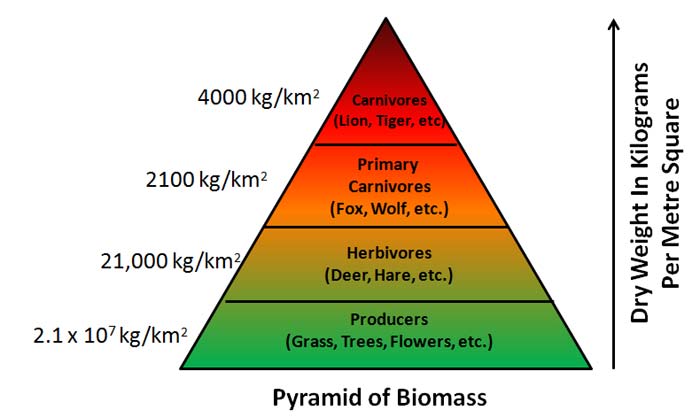 Biomass is also used as a source of renewable energy in replacement of fossil fuels. This alternative has dramatically helped in the improvement of the planet’s climatic conditions. A wide variety of benefits can be obtained from the utilization of biomass as a fuel, and they include the reduction of wastes and low costs.
Biomass is also used as a source of renewable energy in replacement of fossil fuels. This alternative has dramatically helped in the improvement of the planet’s climatic conditions. A wide variety of benefits can be obtained from the utilization of biomass as a fuel, and they include the reduction of wastes and low costs.
![]()
3. Pyramid of Energy
- The pattern of the energy flow in this type of pyramid is based on the principles of thermodynamics. This law specifically says that energy is neither be created nor destroyed; only transformed into another form.
- This pyramid shows that energy is transferred from lower trophic levels with more amount of energy (producers) to higher ones (consumers) and converted in the biomass.
- Therefore, it can be concluded that organisms found at the highest trophic levels of shorter food chains bear a greater amount of energy than the ones found in longer ones.
- Unlike the first two ecological pyramids, the pyramid of energy is always illustrated in an upright position, with the largest energy carriers at the base.
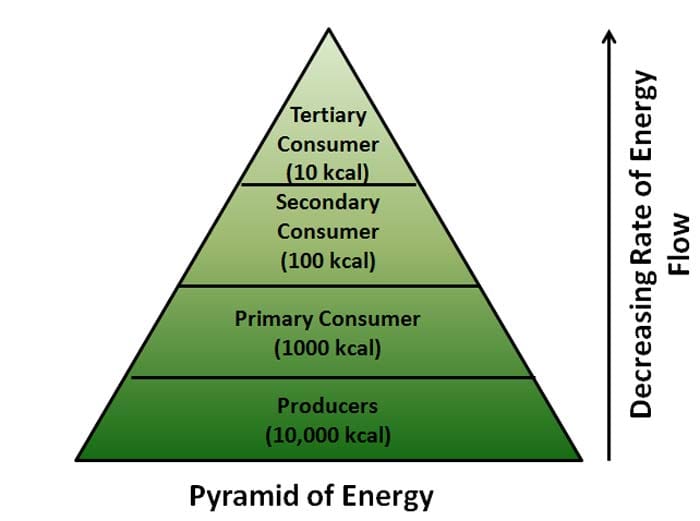 The idea of the pyramid of energy is very crucial in the idea of biological magnification, which is defined as the tendency of toxic substances to increase in amount as you go up the trophic levels.
The idea of the pyramid of energy is very crucial in the idea of biological magnification, which is defined as the tendency of toxic substances to increase in amount as you go up the trophic levels.
![]()
Limitations of Ecological Pyramids
- These types of pyramids only are applicable in simple food chains (and not food webs), which do not necessarily occur naturally. They also do not consider the possible presence of the same species at different trophic levels.
- Moreover, none of the three ecological pyramids provide any idea related to variations in seasons and climates.
- Other organisms like microorganisms and fungi are not given specific role in the pyramids despite their vital roles in ecosystems.
![]()
With such diversity of organisms on our planet, don’t you wonder how organisms still manage to stay in a manner so accurate yet complex?
![]()
Cite This Page
References
- “Ecological Pyramid | Pyramid of Numbers with Diagram | [email protected]”. Accessed April 09, 2017. Link.
- “Ecological Pyramids – Pyramid of numbers, biomass & energy | PMF IAS”. Accessed April 09, 2017. Link.
- “BBC – GCSE Bitesize: Food chains and pyramids”. Accessed April 09, 2017. Link.


